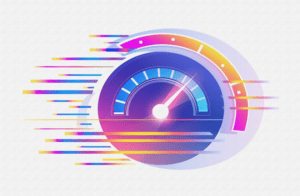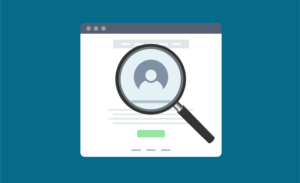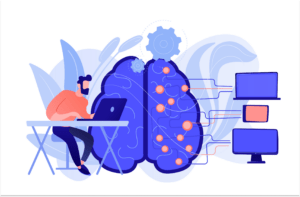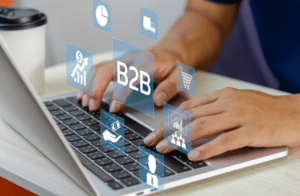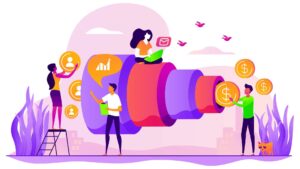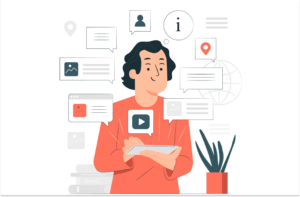According to a study by HubSpot, 68% of B2B companies do not leverage a full funnel marketing strategy. Instead of guiding prospects smoothly from initial awareness to final purchase, many businesses focus only on specific steps, often targeting leads who are ready to buy while neglecting those who are just beginning to explore solutions. In this guide, we are going to go through why a full funnel marketing strategy is important, and how to attract and nurture leads at each stage of the funnel.
Why is a Full Funnel Marketing Strategy Important?
A sales funnel is a visual model that represents the journey a prospect takes as they become aware of, engage with, and ultimately purchase a product or service. It’s commonly divided into stages that start broadly and narrow down, just like a funnel, illustrating how an audience is filtered and qualified throughout the buyer’s journey. Focusing on all funnel stages rather than only targeting people ready to buy provides a more stable foundation for sustainable growth. It also establishes trust, as each interaction with potential customers adds value and credibility, which in turn builds stronger customer relationships.
Understanding the Stages of a Full Funnel Marketing Strategy
The full funnel strategy is typically broken down into three main stages: the top, middle, and bottom of the funnel. Let’s explore each stage and discuss strategies to attract leads at every step.
1. Top of Funnel (TOFU): Building Awareness
The top of the funnel is all about awareness. At this stage, potential customers are just discovering your brand, product, or service. They may have a problem or a need, but they aren’t yet aware of the solutions available. The primary goal at the top of the funnel is to introduce your brand and attract an audience through content that educates and informs. Here are a few ways to build awareness.
Educational Blog Posts
One of the best ways to build awareness is writing educational blog posts that answer common questions that your target audience may have. You can come up with these ideas by analyzing your current client’s FAQs, looking at your competitor’s content, or using a tool like SEMRush to dig up trending topics. For example, here at Visitor Queue, we target B2B companies and sell lead generation software. So, a lot of our content revolves around B2B marketing and lead generation strategies. It can be helpful to start with broad content that will attract a lot of visitors, and then niche down from there.
Social Media Content
Utilize social platforms like Instagram, LinkedIn, and Facebook to share content that resonates with your audience’s interests. Share relevant industry news, tips, or even humorous content that aligns with your brand personality. Social media is a powerful tool at this stage, as it allows your audience to discover your brand in a casual, low-commitment environment. As a B2B company, typically LinkedIn will be the best platform to post in terms of finding the right audience. But, it can also be helpful to post on all platforms so you can reach more people.
Video Content and Tutorials
Video content has high engagement rates and can effectively grab attention. Short videos, educational tutorials, or even brand story videos introduce viewers to your company and can encourage them to seek out more information. In my experience, YouTube Shorts and Instagram Reels get the most engagement in terms of short form video content. The content created at the top of the funnel should focus on adding value without pushing a sale. It’s a soft entry into your audience’s awareness, with the goal of piquing interest.
2. Middle of Funnel (MOFU): Generating Interest and Nurturing Leads
Once a prospect is aware of your brand, they move into the middle of the funnel. Here, they’re in the research phase and are considering potential solutions to their problem. At this stage, your content and messaging should provide more detailed information to build trust and position your brand as a viable solution. Content in this stage should offer in-depth insights, highlight your expertise, and address specific pain points of your target audience.
Case Studies and Testimonials
Showcasing past successes with real clients builds credibility and helps potential customers envision the results they could achieve. If you offer digital marketing solutions, share a case study on how you helped a client increase their lead conversion by 40% in six months. This evidence-based content demonstrates your capabilities and reinforces trust. Showcase your case studies on your website, social media channels, or even with paid advertising.
Webinars
Webinars are a great way to showcase your expertise and build trust with prospects. Offering an in-depth webinar on an industry topic or a live demo of your product is highly effective at this stage. For instance, if you’re in the software business, you could host a live demo showing how your tool solves common workflow bottlenecks. This format allows prospects to ask questions, clarify doubts, and see your product in action. In turn, this can significantly boost interest and engagement. Additionally, if you record the webinar, you can publish it on your website as gated content to continue generating interest.
Whitepapers and eBooks
Providing downloadable, in-depth resources such as whitepapers or eBooks can serve as lead magnets. For example, every year HubSpot releases various marketing reports that include the data they have collected from their users throughout the year. This type of resource demonstrates your expertise and offers substantial value, encouraging prospects to further explore your solutions. Engagement at the middle of the funnel centers around educating the lead about your solutions while subtly emphasizing why your brand is a top choice.
3. Bottom of Funnel (BOFU): Driving Conversions
At the bottom of the funnel, potential customers are ready to make a decision. They’re aware of your brand, they’ve done their research, and now they’re choosing between you and your competitors. Your role here is to make the decision-making process as straightforward as possible. You’ll want to offer clear benefits and supporting their choice with targeted content and offers.
Company Comparisons
Oftentimes, B2B industries are competitive. So, it can be helpful to create landing pages that go over top questions, concerns, and features of your company versus your competitors. Then, you can use this in organic and paid search strategies to help both first time prospects and prospects who are looking to switch solutions. Below is an example of a Google Ad that appears when searching for Salesforce. Here, Iterable is bidding on Salesforce keywords. Then, people who click on this ad are directed to a landing page that goes over the pros and cons of both.
Free Trials and Demos
Offering a free trial or demo can be the final nudge a prospect needs to convert. For example, if you sell a project management tool, a 14-day free trial allows users to experience its benefits firsthand. This direct interaction often leads to higher conversion rates, as potential customers see the immediate value of your solution.
Discounts and Limited Time Offers
Sometimes, all it takes to convert a lead is a well-timed offer. An example of this would be to follow up with leads who had a demo, but didn’t convert within the first 30 days, and offer them a 10% discount if they purchase by the end of the month. These offers can create urgency and encourage prospects to make a decision if they are on the fence.

The Importance of Post-Purchase Engagement
A full funnel marketing strategy doesn’t end with the purchase. Retaining customers and turning them into repeat buyers is essential for building loyalty and driving long-term growth. After a customer converts, focus on providing ongoing value through follow-up communication, support, and exclusive offers. Here are a few ways to do just that.
Onboarding Emails
Once a customer signs up or makes a purchase, send a welcome email that provides information on how to get the most out of your product or service. This could include user guides, quick start videos, or tips for optimizing usage. Additionally, provide a way to easily reach out to sales if they have any questions about getting started. If you’re not sure how to properly onboard new clients, check out our article How to Onboard New Customers.
Customer Satisfaction Surveys
Asking for feedback shows that you value their experience and can help you improve. For example, if you’re a B2B software provider, you might send a satisfaction survey after three months, asking how the tool has impacted their business operations. This approach not only helps you identify areas for improvement, but also signals to the customer that their satisfaction is a priority.
Loyalty and Referral Programs
Reward loyal customers by offering exclusive content, early access to new features, referral programs or discounts. One way that we reward our loyal customers while generating new customers is offering a referral program. Here, our current customers can refer other businesses. The client who does the referral can earn recurring rewards when the other company signs up. This encourages them to refer even more.

Additional Considerations
Now that you know how to attract and nurture leads at each stage of the funnel, let’s go over some other important things to consider when creating a full funnel marketing strategy.
Leverage your CRM
One of the most important parts of building a full funnel marketing strategy is your CRM. Your CRM enables you to manage, track, and analyze interactions with leads and customers across every stage of the funnel. In turn, providing valuable insights to improve your marketing efforts. By centralizing customer data, your CRM helps create personalized experiences tailored to each lead’s position in the funnel, increasing the relevance and effectiveness of your outreach.
For instance, at the top of the funnel, CRM data can reveal which channels and content types bring in the highest volume of leads, helping you refine your content marketing strategy. In the middle of the funnel, CRM automation allows you to send personalized follow-ups, nurturing leads with the right information based on their past interactions. At the bottom of the funnel, CRM data on customer preferences and behaviors can inform special offers or product recommendations. In turn, easing the path to conversion.
Identify Your Website Visitors
When you are trying to build and optimize your full funnel marketing strategy, it’s extremely helpful to know what companies are on your website. With the help of Visitor Queue, you can see what companies land on your website, how they got there, the pages they viewed, and how long they spent on each page. Additionally, we provide an overview of who the company is, their website and socials, size, industry, and more that can help you qualify their needs. And, you can also gain access to employee contact information to reach out and ensure they found what they were looking for.
When you know more about your visitors, you can create targeted campaigns that speak to their specific needs. For instance, if you see that a particular company has visited your pricing page multiple times, it’s a clear signal that they’re likely in the middle of the funnel and may be considering your solution. This insight allows you to initiate tailored email outreach, provide additional resources, or even offer a personalized demo.
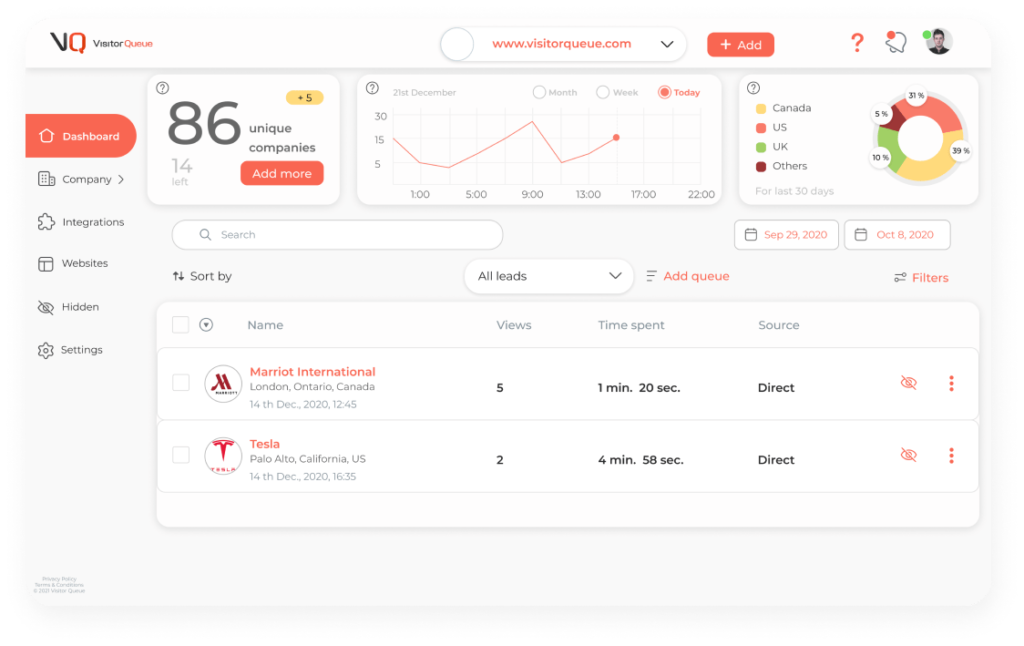
Ask For Feedback
Customer feedback is invaluable in refining your full-funnel strategy and ensuring each stage meets your audience’s needs. Feedback allows you to identify gaps in your marketing efforts, improve customer satisfaction, and discover opportunities for new content or product features. Whether through surveys, post-purchase emails, or direct conversations, asking for feedback helps you understand what resonates with customers. And, where adjustments are needed. For example, if you meet with a prospect and give them a product demo, but they don’t convert, simply follow up via email and ask why.
What’s Next?
Ultimately, a full funnel marketing strategy is about more than just attracting leads. It’s about guiding each person through a meaningful customer journey that builds trust and provides value at every step. When each stage of the funnel is addressed with purpose, potential customers experience a journey that feels personalized, relevant, and engaging. As always, if you have any questions about using Visitor Queue to identify your website visitors, do not hesitate to reach out.
 Identify
Identify Personalize
Personalize Benchmark
Benchmark Agencies
Agencies Integrations
Integrations Case Studies
Case Studies Use Cases
Use Cases Blog
Blog Resources
Resources
